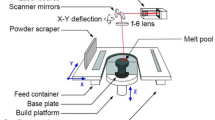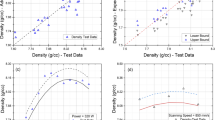Abstract
The building of practical parts involves the application of metal-based powder bed fusion using a laser beam (PBF-LB/M), owing to its high-precision manufacturing. However, the quality of built parts obtained via the PBF-LB/M process varies with the building conditions, and a thorough understanding of the building mechanism has not been achieved owing to the complex and interrelated process parameters involved. The incident angle of the laser beam, which changes on the platform during the laser beam scan owing to the designed three-dimensional data, is among the principle parameters that affect the building aspects. In this study, the melt pool in the single-track formation during the PBF-LB/M process was visualised using a high-speed camera, and the influence of the laser incident angle on the ejection characteristics of spatter particles formed around the laser-irradiated area was investigated. Consequently, the spatter particles and metal vapour jets behaviour varied with the laser incident angle. There was a reduction in number of spatter particles owing to the origin of the incident direction being from behind the laser irradiation area. Additionally, the laser incident angle affected the melt pool morphology because of the depression in the melting. Furthermore, the burial depth of the pores varied with the laser incident angle, and was related to the depth of the depression during the melt pool formation.












Similar content being viewed by others
References
ASTM F2792–10e1 (2012) Standard terminology for additive manufacturing technologies. Annual book of ASTM Standard, ASTM International, Pennsylvania 671–673
Vayre B, Vignat F, Villeneuve F (2012) Designing for additive manufacturing Proc CIRP 3:632–637. https://doi.org/10.1016/j.procir.2012.07.108
Plessis AD, Yadroitsava I, Yadroitsav I (2018) Ti6Al4V lightweight lattice structures manufactured by laser powder bed fusion for load-bearing applications. Opt Laser Technol 108:521–528. https://doi.org/10.1016/j.optlastec.2018.07.050
Tan C, Wang D, Ma W, Chan Y, Chen S, Yang Y, Zhou K (2020) Design and additive manufacturing of novel conformal cooling molds. Mater Des 196:109147. https://doi.org/10.1016/j.matdes.2020.109147
Nadimpalli VK, Dahmen T, Valente EH, Mohanty S, Pedersen DB (2019) Multi-material additive manufacturing of steels using laser powder bed fusion. Eur Soc Precis Eng Nanotechnol 240–243
Bayat M, Thanki A, Mohanty S, Witvrouw A, Yang S, Thorborg J, Tiedje NS, Hattel JH (2019) Keyhole-induced porosities in laser-based powder bed fusion (L-PBF) of Ti6Al4V: high-fidelity modelling and experimental validation. Addit Manuf 30:100835. https://doi.org/10.1016/j.addma.2019.100835
Bertoli US, Wolfer AJ, Matthews MJ, Delplanque JR, Schoenung JM (2017) On the limitations of volumetric energy density as a design parameter for selective laser melting. Mater Des 113(5):331–340. https://doi.org/10.1016/j.matdes.2016.10.037
Metelkova J, Kinds Y, Kempen K, Formanoir C, Witvrouw A, Hooreweder BV (2018) On the influence of laser defocusing in selective laser melting of 316L. Addit Manuf 23:161–169. https://doi.org/10.1016/j.addma.2018.08.006
Qiu C, Panwisawas C, Ward M, Basoalto HC, Brooks JW, Attallah MM (2015) On the role of melt flow into the surface structure and porosity development during selective laser melting. Acta Mater 96(1):72–79. https://doi.org/10.1016/j.actamat.2015.06.004
Gu DD, Meiners W, Wissenbach K, Poprawe R (2012) Laser additive manufacturing of metallic components: materials, processes and mechanisms. Int Mater Rev 57(3):133–164. https://doi.org/10.1179/1743280411Y.0000000014
Sato N, Seto N, Shimizu T, Nakano S (2017) Real-time observation of melting behaviour in selective laser melting of metals. Mater Japan 56(12):695–698
Wang D, Yang Y, Liu R, Xiao D, Sun J (2013) Study on the designing rules and processability of porous structure based on selective laser melting (SLM). J Mater Process Technol 213(10):1734–1742. https://doi.org/10.1016/j.jmatprotec.2013.05.001
Arai T (2013) Fundamental engineering science for laser materials processing. Maruzen Publishing Co. Ltd., Tokyo
Ladewig A, Schlick G, Fisser M, Schulze V, Glatzel U (2016) Influence of the shielding gas flow on the removal of process by-products in the selective laser melting process. Addit Manuf 10:1–9. https://doi.org/10.1016/j.addma.2016.01.004
Miyazaki Y, Katayama S (2013) Influence of laser-induced plume on penetration in laser welding. Q J Jpn Weld Soc 31(2):119–125. https://doi.org/10.2207/qjjws.31.119
Bidare P, Bitharas I, Ward RM, Attallah MM, Moore AJ (2018) Fluid and particle dynamics in laser powder bed fusion. Acta Mater 142(1):107–120. https://doi.org/10.1016/j.actamat.2017.09.051
Matthews MJ, Guss G, Khairallah SA, Rubenchik AM, Depond PJ, King WE (2016) Denudation of metal powder layers in laser powder bed fusion processes. Acta Mater 114(1):33–42. https://doi.org/10.1016/j.actamat.2016.05.017
Sendino S, Gardon M, Lartategui F, Martinez S, Lamikiz A (2020) The effect of the laser incidence angle in the surface of L-PBF processed parts. Coat 10(11):1024. https://doi.org/10.3390/coatings10111024
Leuders S, Thöne M, Riemer A, Niendorf T, Tröster T, Richard HA, Maier HJ (2013) On the mechanical behaviour of titanium alloy TiAl6V4 manufactured by selective laser melting: fatigue resistance and crack growth performance. Int J Fatigue 48:300–307. https://doi.org/10.1016/j.ijfatigue.2012.11.011
Furumoto T, Egashira K, Oishi K, Abe S, Yamagu-chi M, Hashimoto Y, Koyano T, Hosokawa A (2021) Experimental investigation into the spatter particle behaviour of maraging steel during selective laser melting. J Adv Mech Des Syst Manuf 15(4):JAMSDM0039. https://doi.org/10.1299/jamdsm.2021jamdsm0039
Guo Q, Zhao C, Escano LI, Young Z, Xiong L, Fezzaa K, Everhart W, Brown B, Sun T, Chen L (2018) Transient dynamics of powder spattering in laser powder bed fusion additive manufacturing process revealed by in-situ high-speed high-energy x-ray imaging. Acta Mater 151:169–180. https://doi.org/10.1016/j.actamat.2018.03.036
Liu Y, Yang Y, Mai S, Wang D, Song C (2015) Investigation into spatter behaviour during selective laser melting of AISI 316L stainless steel powder. Mater Des 87(15):797–806. https://doi.org/10.1016/j.matdes.2015.08.086
Andani MT, Dehghani R, Ravari MRK, Mirzaeifar R, Ni J (2017) Spatter formation in selective laser melting process using multi-laser technology. Mater Des 131(5):460–469. https://doi.org/10.1016/j.matdes.2017.06.040
Wang D, Wu S, Fu F, Mai S, Yang Y, Liu Y, Song C (2017) Mechanisms and characteristics of spatter generation in SLM processing and its effect on the properties. Mater Des 117(5):121–130. https://doi.org/10.1016/j.matdes.2016.12.060
Furumoto T, Ueda T, Kobayashi N, Yassin A, Hosokawa A, Abe S (2009) Study on laser consol-idation of metal powder with Yb:fiber laser—evaluation of line consolidation structure. J Mater Process Technol 209(18–19):5973–5980. https://doi.org/10.1016/j.jmatprotec.2009.07.017
Khairallah SA, Anderson AT, Rubenchik A, King WE (2016) Laser powder-bed fusion additive manufacturing: Physics of complex melt flow and formation mechanisms of pores, spatter, and denudation zones. Acta Mater 108(15):36–45. https://doi.org/10.1016/j.actamat.2016.02.014
Steen WM, Mazumder J (2010) Laser material processing, 4th edn. Springer, London. https://doi.org/10.1007/978-1-84996-062-5
King WE, Barth HD, Castillo VM, Gallegos GF, Gibbs JW, Hahn DE, Kamath C, Rubenchik AM (2014) Observation of keyhole-mode laser melting in laser powder-bed fusion additive manufacturing. J Mater Process Technol 214(12):2915–2925. https://doi.org/10.1016/j.jmatprotec.2014.06.005
Ly S, Rubenchik AM, Khairallah SA, Guss G, Matthews MJ (2017) Metal vapor micro-jet controls material redistribution in laser powder bed fusion additive manufacturing. Sci Rep 7:4085. https://doi.org/10.1038/s41598-017-04237-z
Gao M, Kawahito Y, Kajii S (2017) Observation and understanding in laserwelding of pure titanium at subatmospheric pressure. Opt Express 25(12):13539–13548. https://doi.org/10.1364/OE.25.013539
Cunningham R, Zhao C, Parab N, Kantzos C, Pauza J, Fezzaa K, Sun T, Rollett AD (2019) Keyhole thresh-old and morphology in laser melting revealed by ultrahigh-speed x-ray imaging distribution on the powder bed during selective laser melting. Science 363(6429):849–852. https://doi.org/10.1126/science.aav4687
Young ZA, Guo Q, Parab ND, Zhao C, Qu M, Escano LI, Fezzaa K, Everhart W, Sun T, Chen L (2020) Types of spatter and their features and formation mechanisms in laser powder bed fusion additive manufacturing process. Addit Manuf 36:101438. https://doi.org/10.1016/j.addma.2020.101438
Kawahito Y, Nakada K, Uemura Y, Mizutani M, Nishimoto K, Kawakami H, Katayama S (2018) Relationship between melt flows based on three-dimensional X-ray transmission in-situ observation and spatter reduction by angle of incidence and defocus distancing distance in high-power laser welding of stainless steel. Weld Int 32(7):485–496. https://doi.org/10.1080/01431161.2017.1346887
Kawahito Y, Kinoshita K, Matsumoto N, Mizutani M, Katayama S (2007) Interaction between laser beam and plasma/plume induced in welding of stainless steel with ultra-high power density fiber laser. Q J Jpn Weld Soc 25(3):461–467. https://doi.org/10.2207/qjjws.25.461
Anwar AB, Pham QC (2018) Study of the spatter distribution on the powder bed during selective laser melting. Addit Manuf 22:86–97. https://doi.org/10.1016/j.addma.2018.04.036
Zhao C, Parab ND, Li X, Fezzaa K, Tan W, Rollett AD, Sun T (2020) Critical instability at moving keyhole tip generates porosity in laser melting. Science 370(6520):1080–1086. https://doi.org/10.1126/science.abd1587
Ng GKL, Jarfors AEW, Bi G, Zheng HY (2009) Porosity formation and gas bubble retention in laser metal deposition. Appl Phys A 97:641. https://doi.org/10.1007/s00339-009-5266
Author information
Authors and Affiliations
Contributions
TK conducted the in-process monitoring, evaluated the obtained data, organised all data, and wrote the manuscript. FT proposed the experiment and evaluation method to reveal the effect of the laser incident angle on melting phenomena, conducted the in-process monitoring, and evaluated the obtained data. YM evaluated the cross-section of a single track using an optical microscope. EA evaluated the depression at the final edge of a single track using X-ray CT. YS, OM, and SK supplied the metal powder and evaluated the obtained data.
Corresponding author
Ethics declarations
Ethics approval
Not applicable.
Consent to participate
Not applicable.
Consent for publication
Not applicable.
Conflict of interest
The authors declare no competing interests.
Additional information
Publisher's Note
Springer Nature remains neutral with regard to jurisdictional claims in published maps and institutional affiliations.
Rights and permissions
About this article
Cite this article
Tsubouchi, K., Furumoto, T., Yamaguchi, M. et al. Evaluation of spatter particles, metal vapour jets, and depressions considering influence of laser incident angle on melt pool behaviour. Int J Adv Manuf Technol 120, 1821–1830 (2022). https://doi.org/10.1007/s00170-022-08887-w
Received:
Accepted:
Published:
Issue Date:
DOI: https://doi.org/10.1007/s00170-022-08887-w




